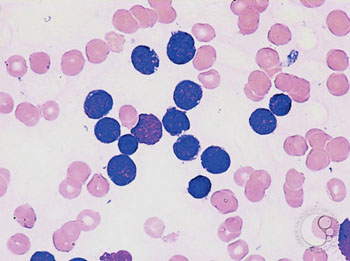Two New Types Of Childhood Leukemia Discovered
By LabMedica International staff writers
Posted on 22 Jun 2016
Acute lymphoblastic leukemia is a rare disease, but the most common form of cancer in children and nowadays the treatment is very successful, but requires intense interventions at the risk of causing many side effects.Posted on 22 Jun 2016
There is therefore a need to distinguish between different types of acute lymphoblastic leukemia, in order to adapt the treatment according to the severity of each case, and to detect possible relapse. Previous studies of childhood acute lymphoblastic leukemia have shown that there are six major groups of acute lymphoblastic leukemia in children.

Image: A blood film of a pediatric patient with B-cell precursor acute lymphoblastic leukemia (Photo courtesy of Dr. Peter Maslak, MD).
A large team of international scientists led by those at Lund University (Sweden) studied leukemia cells from more than 200 children using next-generation sequencing technology (NGS), and were able to study the genome of cancer cells, which is how they discovered the two new types of cancer. The discovered two new types, together representing about 10% of all childhood leukemia, can now be added to the other groups.
The investigators were able to delineate the fusion gene landscape in a consecutive series of 195 pediatric B-cell precursor acute lymphoblastic leukemia (BCP ALL). They used ribonucleic acid (RNA) sequencing, to find in-frame fusion genes in 127 (65%) cases, including 27 novel fusions. They describe a subtype characterized by recurrent IGH-DUX4 or ERG-DUX4 fusions, representing 4% of cases, leading to overexpression of DUX4 and frequently co-occurring with intragenic ERG deletions. They identified a subtype characterized by an ETV6-RUNX1-like gene-expression profile and coexisting ETV6 and IKZF1 alterations. The study provides a detailed overview of fusion genes in pediatric BCP ALL and added new pathogenetic insights, which may improve risk stratification and provide therapeutic options for this disease.
Thoas Fioretos, MD, PhD, a professor and principal investigator of the study said, “Like all types of cancer, childhood leukemia is caused by genetic mutations in normal cells, which are then transformed into cancer cells. Finding the critical mutations in the diseased cells are an important condition for understanding the mechanisms of the disease and ultimately discovering new therapies,” The study was published on June 6, 2016, in the journal Nature Communications.
Related Links:
Lund University













